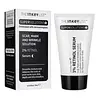What's inside
What's inside
 Key Ingredients
Key Ingredients

 Benefits
Benefits

 Concerns
Concerns

No concerns
 Ingredients Side-by-side
Ingredients Side-by-side

Water
Skin ConditioningCaprylic/Capric Triglyceride
MaskingPropanediol
SolventGlycerin
HumectantTocopherol
AntioxidantAscorbyl Glucoside
AntioxidantBakuchiol
AntimicrobialSolanum Melongena Fruit Extract
Skin ConditioningCurcuma Longa Root Extract
MaskingOcimum Basilicum Flower/Leaf Extract
TonicCoccinia Indica Fruit Extract
Skin ConditioningAloe Barbadensis Flower Extract
EmollientMelia Azadirachta Flower Extract
Skin ConditioningMelia Azadirachta Leaf Extract
Skin ConditioningOcimum Sanctum Leaf Extract
Skin ConditioningMarrubium Vulgare Extract
Skin ConditioningCorallina Officinalis Extract
Skin ConditioningSimmondsia Chinensis Seed Oil
EmollientXanthan Gum
EmulsifyingSodium Levulinate
Skin ConditioningPotassium Sorbate
PreservativeSodium Benzoate
MaskingCitric Acid
BufferingWater, Caprylic/Capric Triglyceride, Propanediol, Glycerin, Tocopherol, Ascorbyl Glucoside, Bakuchiol, Solanum Melongena Fruit Extract, Curcuma Longa Root Extract, Ocimum Basilicum Flower/Leaf Extract, Coccinia Indica Fruit Extract, Aloe Barbadensis Flower Extract, Melia Azadirachta Flower Extract, Melia Azadirachta Leaf Extract, Ocimum Sanctum Leaf Extract, Marrubium Vulgare Extract, Corallina Officinalis Extract, Simmondsia Chinensis Seed Oil, Xanthan Gum, Sodium Levulinate, Potassium Sorbate, Sodium Benzoate, Citric Acid
Water
Skin ConditioningGlycerin
HumectantPrunus Armeniaca Kernel Oil
MaskingPersea Gratissima Oil
Skin ConditioningCaprylic/Capric Triglyceride
MaskingSqualane
EmollientCetearyl Alcohol
EmollientGlyceryl Stearate Se
EmulsifyingRetinol
Skin ConditioningPhenoxyethanol
PreservativeHydroxyethyl Acrylate/Sodium Acryloyldimethyl Taurate Copolymer
Emulsion StabilisingBenzyl Alcohol
PerfumingPhospholipids
Skin ConditioningTocopherol
AntioxidantPolyacrylate Crosspolymer-6
Emulsion StabilisingGlycine Soja Oil
EmollientEthylhexylglycerin
Skin ConditioningGlycolipids
Skin ConditioningDehydroacetic Acid
PreservativePolysorbate 60
EmulsifyingSorbitan Isostearate
EmulsifyingTrisodium Ethylenediamine Disuccinate
Glycine Soja Sterols
EmollientT-Butyl Alcohol
PerfumingWater, Glycerin, Prunus Armeniaca Kernel Oil, Persea Gratissima Oil, Caprylic/Capric Triglyceride, Squalane, Cetearyl Alcohol, Glyceryl Stearate Se, Retinol, Phenoxyethanol, Hydroxyethyl Acrylate/Sodium Acryloyldimethyl Taurate Copolymer, Benzyl Alcohol, Phospholipids, Tocopherol, Polyacrylate Crosspolymer-6, Glycine Soja Oil, Ethylhexylglycerin, Glycolipids, Dehydroacetic Acid, Polysorbate 60, Sorbitan Isostearate, Trisodium Ethylenediamine Disuccinate, Glycine Soja Sterols, T-Butyl Alcohol
Ingredients Explained
These ingredients are found in both products.
Ingredients higher up in an ingredient list are typically present in a larger amount.
This ingredient is an emollient, solvent, and texture enhancer. It is considered a skin-softener by helping the skin prevent moisture loss.
It helps thicken a product's formula and makes it easier to spread by dissolving clumping compounds.
Caprylic Triglyceride is made by combining glycerin with coconut oil, forming a clear liquid.
While there is an assumption Caprylic Triglyceride can clog pores due to it being derived from coconut oil, there is no research supporting this.
Learn more about Caprylic/Capric TriglycerideGlycerin is already naturally found in your skin. It helps moisturize and protect your skin.
A study from 2016 found glycerin to be more effective as a humectant than AHAs and hyaluronic acid.
As a humectant, it helps the skin stay hydrated by pulling moisture to your skin. The low molecular weight of glycerin allows it to pull moisture into the deeper layers of your skin.
Hydrated skin improves your skin barrier; Your skin barrier helps protect against irritants and bacteria.
Glycerin has also been found to have antimicrobial and antiviral properties. Due to these properties, glycerin is often used in wound and burn treatments.
In cosmetics, glycerin is usually derived from plants such as soybean or palm. However, it can also be sourced from animals, such as tallow or animal fat.
This ingredient is organic, colorless, odorless, and non-toxic.
Glycerin is the name for this ingredient in American English. British English uses Glycerol/Glycerine.
Learn more about GlycerinTocopherol (also known as Vitamin E) is a common antioxidant used to help protect the skin from free-radicals and strengthen the skin barrier. It's also fat soluble - this means our skin is great at absorbing it.
Vitamin E also helps keep your natural skin lipids healthy. Your lipid skin barrier naturally consists of lipids, ceramides, and fatty acids. Vitamin E offers extra protection for your skin’s lipid barrier, keeping your skin healthy and nourished.
Another benefit is a bit of UV protection. Vitamin E helps reduce the damage caused by UVB rays. (It should not replace your sunscreen). Combining it with Vitamin C can decrease sunburned cells and hyperpigmentation after UV exposure.
You might have noticed Vitamin E + C often paired together. This is because it is great at stabilizing Vitamin C. Using the two together helps increase the effectiveness of both ingredients.
There are often claims that Vitamin E can reduce/prevent scarring, but these claims haven't been confirmed by scientific research.
Learn more about TocopherolWater. It's the most common cosmetic ingredient of all. You'll usually see it at the top of ingredient lists, meaning that it makes up the largest part of the product.
So why is it so popular? Water most often acts as a solvent - this means that it helps dissolve other ingredients into the formulation.
You'll also recognize water as that liquid we all need to stay alive. If you see this, drink a glass of water. Stay hydrated!
Learn more about Water